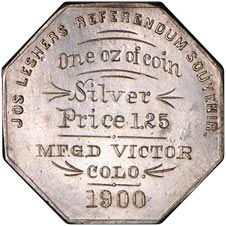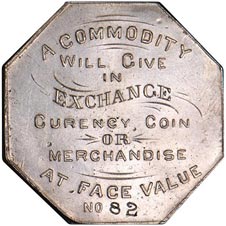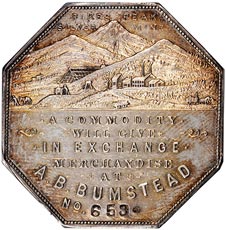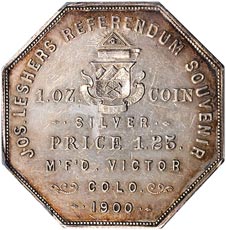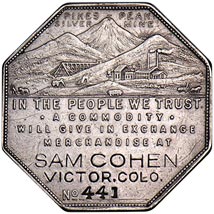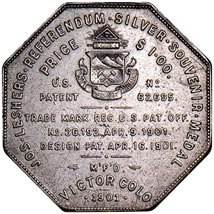LESHER OR REFERENDUM DOLLARS
1900-1901
Joseph W. Lesher (1838-1918), a native of Ohio who for 20 years was Colorado silver camp worker, silver-mine owner and real estate investor, began an issue of silver "Referendum Souvenirs" in his home town of Victor, CO, in November, 1900.
Lesher, an advocate of greater use of silver, believed that if that metal, then depreciated, were to enjoy unlimited coinage, increased business and general prosperity would result. Others, including Davis H. Waite, Colorado governor, and E. O. Wolcott, U.S. senator from Colorado, also held this view, but it remained for Lesher to put theory into practice. He was owner of a silver mine near Central, CO, so perhaps his motive was not altogether unselfish.
An advocate of free coinage of silver in both 1896 and 1900 national elections, even though both times the issues lost at the polls, Lesher still believed in unlimited metal dollar coinage. His own state had endorsed it, and he was convinced that people generally favored it.
He decided to issue silver dollars, which he named "Referendum Souvenirs." He called them "Referendum" because they were referred to the people for acceptance or rejection. No one was forced to take them.
According to a dispatch from Victor to a Chicago newspaper on Nov. 13, 1900, "Mr. Lesher proposes to demonstrate that the 'intrinsic value' theory is a delusion and a snare. His silver at the present quotation costs 65 cents per ounce, the expense of coining is 15 cents--80 cents in all--but he values dollars at $1.25 and intends to keep them above par. Although he is confident that the silver alone is really worth $1.29 an ounce, he admits other people may be prejudiced. Therefore he promises to pay $1.25 in United States money on demand for each 'referendum' dollar. In order to avoid any entanglement with the Government Mr. Lesher makes his dollars eight-sided."
Lesher did sell the first 100 medals himself at their $1.25 face value. He intended to issue and redeem them himself, but when this proved impractical, he arranged with A. B. Bumstead, a local grocer, to use the Referendums in his store and to redeem them in merchandise or cash. Bumstead sold 700 specimens and only three pieces were returned for redemption. It is believed that about 1,000 pieces (including both varieties) of the Bumstead pieces were made.
In late 1900, six die trials were struck for a piece to be used and redeemed by banks, but the bank idea was shelved. Had it not been, Lesher no doubt would have experienced further trouble from the federal government.
Most accounts of the Lesher Referendums state that the dies for the first issue were seized by federal agents, but Dr. Philip W. Whiteley, one authority on the pieces, believes the seizure took place after issue of the Bank Type. He has called attention to the fact that with this variety, Jos. Leshers • Referendum • Souvenir was changed to read Jos • Leshers • Referendum • Silver • Souvenir • Medal •
Dr. Whiteley, who has reported a variety unknown to Zerbe, believes that Lesher, who applied for a trademark Feb. 14, 1901, thought it necessary to submit a piece along with his application. The piece referred to has same reverse as the second Bumstead type. Obverse. Near edge, around, Trade-Mark Applied for; in six straight lines, A / Commodity / Will Give / in Exchange / Merchandise / at; space for imprint; No.
Lesher patented the design of his pieces April 16, 1901 (No. 34,359), and registered his trademark (No. 36,192), "Referendum," April 9, 1901. This was done to forestall counterfeiting of his pieces, which he had pledged to redeem at face value. As Charles E. Briggs, another authority on the pieces, stated in 1920, "This would seem to belie the motto, 'In the People We Trust,' which appears on all of this (1901) issue."
Lesher is believed to have designed the pieces himself, at his residence on W. Victor Ave. Frank Hurd of Denver made dies for the first type; Herman Otto, also of Denver, all other dies. The dies cost Lesher $60 a pair. All Referendums were struck for Lesher by a private Denver firm.
All Lesher pieces are octagonal and have plain edge. The medals dated 1900 are 35mm. across center and weigh one ounce. Those dated 1901 are 32mm. in diameter and are of same weight as a standard silver dollar, 412 1/2 grains. The 1900 pieces bear $1.25 price, while those of 1901 have price $1.00. Their composition is silver .950 fine, alloyed with copper.
Serial numbers were hand punched or engraved. No systematic numbering system was employed, so numbers bear no relationship between series, to series as a whole, or to number of pieces issued. Some pieces have period after number; some have not.
The Imprint Type comes without merchant's name entered; also, with and without serial number. Lesher himself said, "Coins with imprint space were supplied to anyone requesting them. Imprint stamps were at the merchant's expense."
The Bumstead pieces come with ornamental scrolls on reverse at sides of State Seal, and without scrolls.
There are other minor varieties in the Referendum series.
The 1901 pieces, like those of the Bank Type, left field blank on lower portion of obverse. The merchant user stamped or engraved his or his firm's name in this space, or had his pieces stamped to order, Average price to merchants was 80-85 cents each.
Merchants who used the Referendums: A. B. Bumstead, Victor, CO, grocer; J. M. Slusher, Cripple Creek, CO, grocer; Sam L. Cohen, Victor, CO, jeweler; David W. Klein, Pueblo, CO, retail liquor dealer; George Mullen, Victor, CO, shoemaker; Boyd Park, Denver, CO, jeweler; W. C. Alexander, Salida, CO, jeweler; Goodspeeds & Co. (L. C. Goodspeed), Colorado Springs, CO, jeweler; J. E. Nelson & Co., Holdrege, NE, clothiers; W. F. White Mercantile Co., Grand Junction, CO, clothiers; H. Stein, believed to be a Canon City, CO, clothier; H. H. Rosser, Victor, CO, stationer and confectioner; and C. W. Thomas, Florence, CO, jeweler. Thomas is reported to have used the pieces, but none has been found with his name imprinted on it.
The Stein and Rosser pieces, which have names engraved, were unknown to Zerbe. Believed to be unique, they may have been engraved by or for Stein and Rosser or by someone else. John J. Ford, Jr., student of the Leshers, has written, "A limited number of business people cooperated with Joseph Lesher. Most of them issued only a few pieces, and others merely played with them, imprinting or engraving only samples. The Referendums were accepted as money in Cripple Creek, Colorado City, Colorado Springs, Victor, and most likely, even in Denver. They also had a limited circulation in Pueblo, but in some places their only use was as trade premiums, or as items for sale as novelties."
Lesher abandoned the plan when he concluded that it would not be a financial success.
(See also "Lesher Referendum Medals: Where Are They Today" by Adna G. Wilde in The Numismatist, February, 1978).
FIRST TYPE
Obv. Jos Leshers Referendum Souvenir, in upper semicircle; below, in six lines, One Oz of Coin / Silver / Price 1.25 / M.F.G.D. Victor / Colo. / 1900.
Rev. In nine lines, A Commodity / Will Give / in / Exchange / Currency Coin / or / Merchandise / at Face Value / No.
HK-787 Silver. Numbers engraved, not punched. Total struck, 100. Zerbe 1.
BUMSTEAD TYPE, FIRST REVERSE
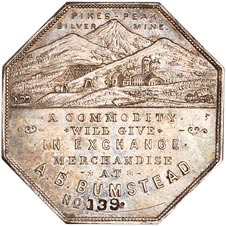
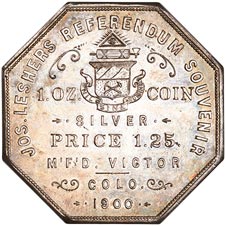
Photos courtesy of American Numismatic Society
Obv. Mountain mining scene, upper half of field; in two lines at top, divided by central mountain peak, Pikes Peak / Silver Mine; in seven lines, on lower half of field • A Commodity • / Will Give / • in Exchange • / Merchandise / --*at*-- / A. B. Bumstead / No.
Rev. Jos. Leshers Referendum Souvenir in upper five-eighths of circle near edge; in center of upper half is a device from the State Seal of Colorado, including its motto, Nil Sine Numine (Nothing Without God), which separates 1 Oz. and Coin; below, in five lines, • Silver • Price 1.25 • / M'f'd Victor / Colo. / 1900
HK-788 Silver. Scrolls at sides of State Seal; line above Colo. Approx. 210 struck. Zerbe 2.
HK-788a Same without number on obverse.
BUMSTEAD TYPE, SECOND REVERSE
Obv. Same as obverse of No. 788 [Mining scene].
Rev. Similar to reverse of No. 788 [Leshers Referendum Souvenir] except no line above Colo, and no scrolls at sides of seal device.
HK-789 Silver. Approx. 500 struck. Zerbe 3.
HK-789a Same without number on obverse.
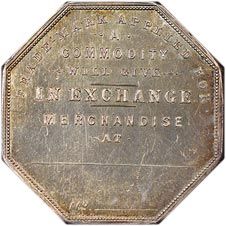
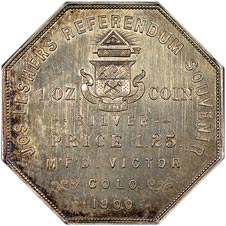
Photos courtesy of NGCcoin.com
Obv. Near edge, around, Trade-Mark Applied for; in six straight lines, A / Commodity / Will Give / in Exchange / Merchandise / at; space for imprint; No.
Rev. Same as reverse of No. 789 [Leshers Referendum Souvenir].
HK-1016 Silver. 35mm. Reported by Dr. Philip W. Whiteley. Zerbe 17.
BANK TYPE
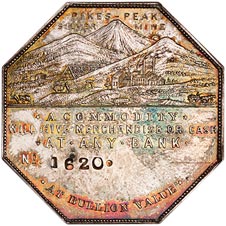
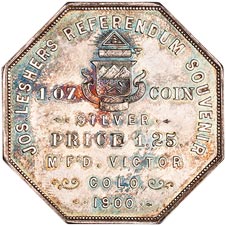
Photos courtesy of American Numismatic Society
Obv. Mining scene, as before; below, in four lines, • A Commodity • / Will Give Merchandise or Cash / • at • Any • Bank • / No. In curved line at bottom, below space left blank for imprint, • At Bullion Value•
Rev. Same as reverse of No. 789 [Leshers Referendum Souvenir].
HK-790 Silver. Approx. 10 pieces, die trials, were struck and bank punch was discarded. Zerbe 4.
HK-790a Same without number on obverse.
IMPRINT TYPE
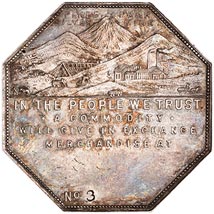
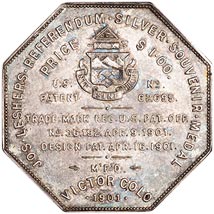
Photos courtesy of American Numismatic Society
Obv. Below same mining scene, in four lines, In the People We Trust. / * A Commodity * / Will Give in Exchange / Merchandise at. Below space for imprint, No.
Rev. In three-quarter circle around top, Jos. Leshers • Referendum• Silver• Souvenir Medal; State Seal device separates Price and $1.00.; to left of device, U.S. / Patent, and to right, No. / 62,695; in six lines below, Trade Mark Reg. U.S. Pat. Off. / No. 36,192. Apr. 9, 1901. / Design Pat. Apr. 16, 1901. / M'f'd / Victor Colo / • 1901•
HK-791 Silver. Zerbe 5.
HK-791a Same without number on obverse.
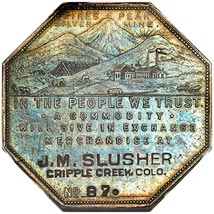
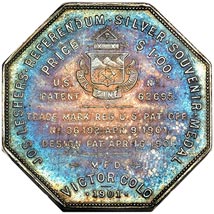
Photos courtesy of Heritage Galleries (HA.com)
HK-792 Same, but stamped J. M. Slusher / Cripple Creek, Colo. Approx. 260 stamped. Zerbe 6
HK-793 Same, but stamped Sam Cohen / Victor, Colo. Approx. 50 stamped. Zerbe 7.
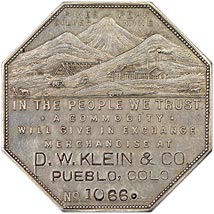
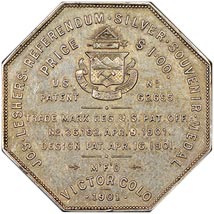
Photos courtesy of NGCcoin.com
HK-794 Same, but stamped D. W. Klein & Co. / Pueblo, Colo. Approx. 100 stamped. Dr. Whiteley reports knowledge of an additional hoard of 17. Zerbe 8.
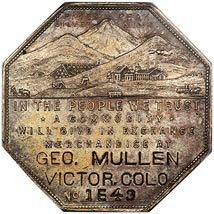
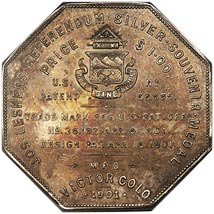
Photos courtesy of Heritage Galleries (HA.com)
HK-795 Same, but stamped Geo. Mullen / Victor, Colo. Approx. 100 stamped. Zerbe 9.
HK-795a Same without number on obverse.
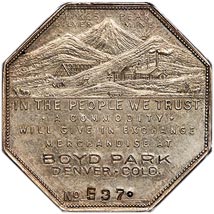
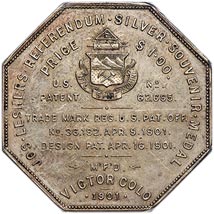
Photos courtesy of Heritage Galleries (HA.com)
HK-796 Same, but stamped Boyd Park / Denver, Colo. Approx. 150 stamped. Zerbe 10.
HK-796a Same without number on obverse.
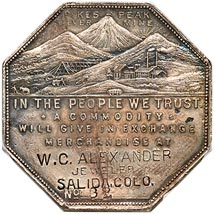
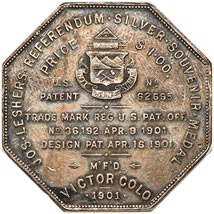
Photos courtesy of Heritage Galleries (HA.com)
HK-797 Same, but stamped W. C. Alexander / Jeweler / Salida, Colo. Second A in Salida is inverted V. Approx. 50 stamped Zerbe 11.
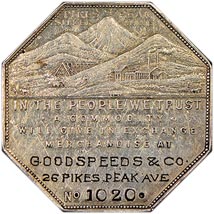
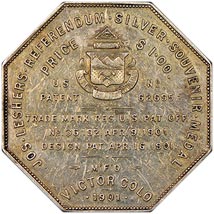
Photos courtesy of NGCcoin.com
HK-1017 Same, but stamped Goodspeeds & Co. / 26 Pikes Peak Ave. Name engraved and serial number punched. Approx. 15 stamped. Zerbe 12.
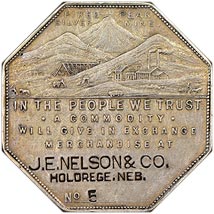
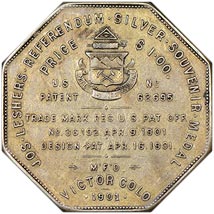
Photos courtesy of NGCcoin.com
HK-1018 Same, but stamped J. E. Nelson & Co. / Holdrege, Neb. Presented to customers during formal opening of the Nelson store. Approx. 50 stamped. Zerbe 13.
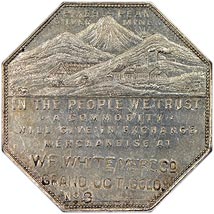
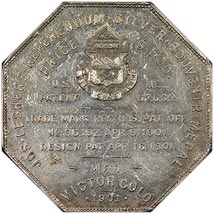
Photos courtesy of NGCcoin.com
HK-1019 Same, but stamped W. F. White Merc. Co. / Grand Jct., Colo. Approx. 50 stamped. Zerbe 14.
HK-1019a Same without number on obverse.
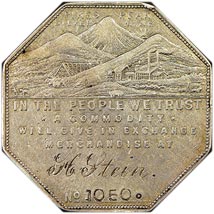
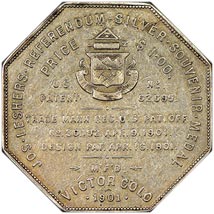
Photos courtesy of NGCcoin.com
HK-1020 Same, but engraved H. Stein. Zerbe 15.
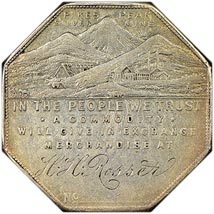
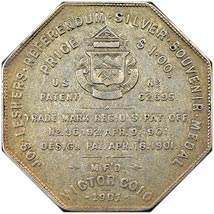
Photos courtesy of NGCcoin.com
HK-1021 Same, but engraved H. H. Rosser. Zerbe 16.
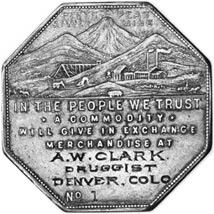
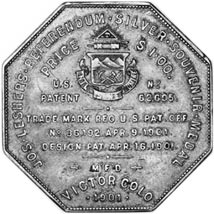
Photos courtesy of Adna Wilde
HK-1021a Same, but engraved A.W. Clark / Druggist / Denver, Colo. Zerbe 18.
HK-777 to HK-786 HK-798 to HK-819